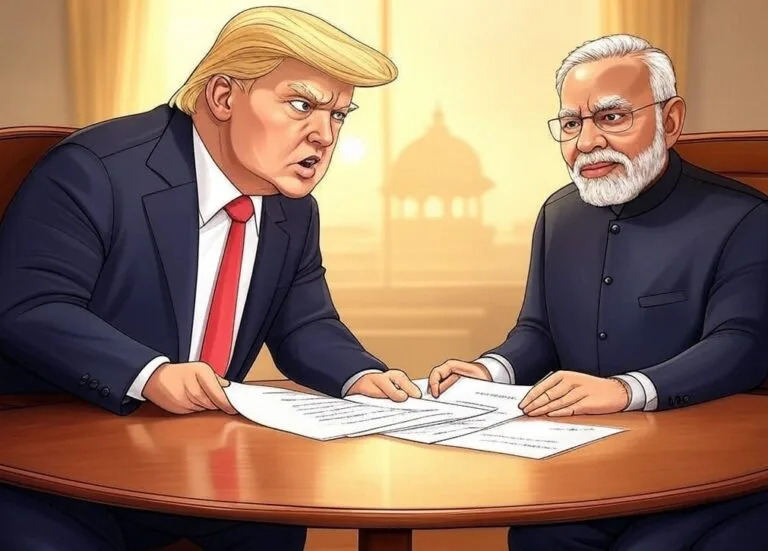India’s Changing Stance on BRICS Currency: Strategic Realignment or Fear of U.S. Economic Repercussions?
For years, the BRICS coalition—comprising Brazil, Russia, India, China, and South Africa—has explored the idea of launching a common currency to reduce dependence on the U.S. dollar in global trade. Initially, Indian Prime Minister Narendra Modi was among the key advocates of this idea, believing that a BRICS-backed financial system could strengthen emerging economies and challenge Western monetary dominance.
However, Modi’s enthusiasm for the BRICS currency has notably diminished in recent years, especially after Donald Trump returned to the U.S. presidency in 2025. This raises a critical question: Why did Modi first support the BRICS currency and then withdraw from the initiative?
In its early stages, Modi viewed the BRICS currency as a tool to boost India’s financial autonomy while fostering closer trade ties with key developing nations. Several factors contributed to his initial support:
- Reducing Dollar Dependence: India, like other BRICS members, has long been wary of U.S. financial dominance. A BRICS currency could have helped bypass Western-controlled financial institutions and insulated India from dollar-based economic fluctuations.
- Strengthening South-South Cooperation: Modi’s government has consistently championed multipolar global finance, emphasizing greater autonomy for the Global South. A BRICS currency aligned with India’s broader goal of reshaping international trade in favor of developing nations.
- Economic Leverage Against the West: At the time, the proposal for a BRICS currency was seen as a counterbalance to U.S. trade restrictions and sanctions, particularly in the wake of escalating tensions between the West and China, Russia, and Iran.
- India’s Digital Payment Push: Given Modi’s focus on financial technology and digital payment systems, there was optimism that India could take a leadership role in shaping a BRICS-based digital currency model.
Despite his early enthusiasm, Modi’s position drastically shifted once the global economic landscape changed—most notably after Donald Trump reassumed office in 2025. Several key developments forced India to reconsider:
- Trump’s Threat of Tariffs and Economic Retaliation: The biggest factor in Modi’s withdrawal appears to be Trump’s aggressive trade policies. Trump openly threatened 100% tariffs on countries that pursued an alternative currency to the U.S. dollar. Given India’s economic dependence on U.S. trade and investment, this was a serious deterrent.
- U.S.-India Strategic Relations: Under Trump, the U.S. has prioritized India as a key regional partner, particularly in countering China’s growing influence. Aligning too closely with China-backed BRICS initiatives could have strained Indo-U.S. ties at a time when India values American defense and technology collaborations.
- Concerns Over Chinese Influence in BRICS: Despite being a founding member, India has long been cautious about BRICS becoming a tool for Chinese financial dominance. A common currency within BRICS would likely be heavily influenced by China’s economic policies, which could sideline India’s interests.
- Assurances from the U.S.: Reports suggest that Trump offered India incentives in exchange for withdrawing from the BRICS currency discussions, possibly in the form of favorable trade agreements and defense deals. India may have opted to secure short-term economic gains rather than engage in a high-stakes financial conflict.
While India has distanced itself from the BRICS currency initiative, Modi’s government remains active in regional trade partnerships and alternative financial mechanisms that promote non-dollar transactions, such as:
- Bilateral trade in local currencies with countries like Russia and UAE.
- Participation in the Asian Clearing Union (ACU) to settle trade payments without the U.S. dollar.
- Expanding India’s own digital payment systems internationally as a competitive alternative.
During a recent press briefing, India’s External Affairs Minister S. Jaishankar clarified:
“BRICS is about economic cooperation, not about weakening the dollar. India is committed to financial partnerships that benefit our people without undermining global stability.” (Reuters)
Modi’s retreat from the BRICS currency initiative was not a simple case of fear or submission—rather, it reflects a pragmatic shift in India’s economic strategy. Faced with Trump’s tariff threats, geopolitical realities, and concerns over China’s dominance, India made the calculated decision to maintain strong U.S. ties while finding alternative ways to enhance financial independence.
While the idea of a BRICS currency remains politically symbolic, its feasibility remains questionable—especially without India’s full participation. For now, Modi appears to have chosen economic realism over ideological alignment, ensuring that India’s global standing remains secure in a volatile international order.

